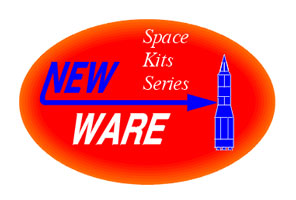Mercury Laboratory Atlas (1960)
About the Design
In the earliest days of America's manned space program, NASA engineers considered ways to extend the Mercury Program beyond its primary goal of putting a man into orbit as quickly, affordably and safely as possible. One of these concepts was a temporary "space laboratory" that could stay aloft for as long as 14 days. Using an Agenda B booster as the launch vehicle's second stage, the Mercury Lab would carry a single astronaut and provide him with 182 cubic feet of working space during his two week-long mission.
The precursor to the Gemini-based Manned Orbiting Laboratory (MOL), the Mercury Lab never got beyond the proposal stage. |
About the Kit
New Ware (Czech Republic) specializes in highly detailed resin models of real space subjects, primarily boosters. However, the company occasionally ventures into authentic "concept" models, such as this little-known Mercury MOL project. Fortunately, most of the components -- the Atlas booster, Agena second stage and even the Mercury capsule -- were already in New War's inventory. Putting them altogether took just a few adaptations. The result was a unique glimpse at "what might have been."
This model was built from an original issue. |


